Filled Surface PropertyManager
Set the PropertyManager options based on the type of filled surface you
want to create.
Patch Boundary
Patch Boundary  defines the edges of the patch you apply. Boundaries include
the following properties and capabilities.
defines the edges of the patch you apply. Boundaries include
the following properties and capabilities.
You can use surfaces or solid edges, as well as
2D or 3D sketches as boundaries for the patch. Composite curves are also
supported.
For all sketch boundaries, you can select only
a Contact patch as the type of
Curvature Control.
Alternate Face
With Alternate Face, you can
flip the boundary face for the curvature control of the patch. Alternate
Face is used only when creating a patch on a solid model.
Curvature Control
Curvature Control defines the
type of control you want to exert on the patch you create. The types of
Curvature Control include:
Contact.
Creates a surface within the selected boundary.
Tangent.
Creates a surface within the selected boundary, but maintains the tangency
of the patch edges.
Curvature.
Creates a surface that matches the curvature of the selected surface across
the boundary edge with the adjacent surface.
You can apply different
types of Curvature Control in
the same patch.
Apply to all edges
The Apply to all edges check
box enables you to apply the same
curvature control to all edges. If you select the function after applying
both Contact and Tangent
to different edges, it applies the current selection to all
edges.
Optimize surface
Select the Optimize
surface option with two or four-sided surfaces. The Optimize
surface option applies a simplified surface patch that is similar
to a lofted surface. Potential advantages of the optimized surface patch
include faster build times, and increased stability when used in conjunction
with other features in the model.
Show preview
Display a shaded preview of the surface fill.
Preview mesh
Display a grid on the patch to help you visualize the curvature. The
Preview mesh is available only
when you select Show preview.
Reverse Surface
Change the direction of the surface patch. The Reverse
Surface button is dynamic, and only displays when all these conditions
are met:
All boundary curves are coplanar
No constraint points exist
No interior constraints
Filled surface is non-planar
-
You select Tangent or Curvature for Curvature
Control
Constraint Curves
Constraint Curves  allow you to add slope control to the patch. They are used
primarily with industrial design applications. You can create a constraint
curve using sketch elements such as sketch points or splines.
allow you to add slope control to the patch. They are used
primarily with industrial design applications. You can create a constraint
curve using sketch elements such as sketch points or splines.
Click on the images below to see examples
of applying Filled Surface
|
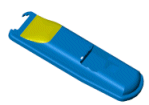
|

|
|
Imported surface example |
Industrial design example |
Resolution Control
If your filled surface is not smooth, you can improve its quality by
adjusting the Resolution Control  slider.
slider.
 The
Resolution Control is available
only when the Optimize Surface
check box is cleared.
The
Resolution Control is available
only when the Optimize Surface
check box is cleared.
The resolution is set to 1 by default. Change the setting to 2 or 3
to increase the number of patches defining the surface. A higher setting
improves the quality of the surface profile.
 Changing
the resolution increases the model size and processing time. You should
not change the default setting if your surface is satisfactory.
Changing
the resolution increases the model size and processing time. You should
not change the default setting if your surface is satisfactory.
|

|

|
|
Quality set to 1 |
Quality set to 2 |
Options
You can create a solid model
with the Filled Surface tool.
Options include:
Fix
up boundary
Merge
result
Try
to form solid
Reverse
direction
Fix up boundary
Constructs a valid boundary by automatically building missing pieces
or trimming pieces that are too big.
|

|
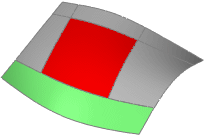
|
|
Surface fill (red) is created despite the gap in the boundary. The gap
between the blue and orange surfaces is bridged by extending the curve
internally to the orange surface. |
Surface fill (red) is created despite the green boundary being larger
than the sides of the fill patch. To create the surface fill, the edges
are split internally. |
Merge result
The behavior for this option
depends on the boundaries.
When all the boundaries belong
to the same solid body, you can use the surface fill to patch the solid.
If at least one of the edges
is an open sheet edge and you select Merge
result, then the Surface Fill
knits with the surfaces to which the edges belong.
If all the boundary entities
are open edges, then a solid may optionally be created.
|
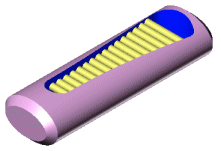
|
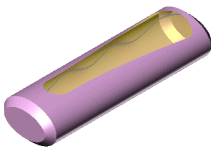
|
|
Model without Filled
Surface applied.
Note the features inside. |
Model with Filled
Surface applied
and Merge result selected.
The surface fill joins the solid,
removing the features inside. |
|
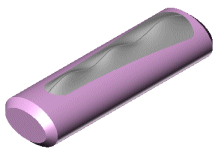
|
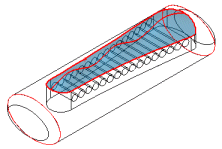
|
|
Model with Filled
Surface applied and Merge result
cleared. The surface fill
creates a new surface, and the features inside remain. |
Merge
result option allows:
Try to form solid
Forming a solid is possible if
all the boundary entities are open surface edges. The option Try
to form solid is cleared by default.
Reverse direction
When patching a solid with a filled surface there are often two possible
results. Click Reverse direction
to correct if the filled surface displays in an unwanted direction.